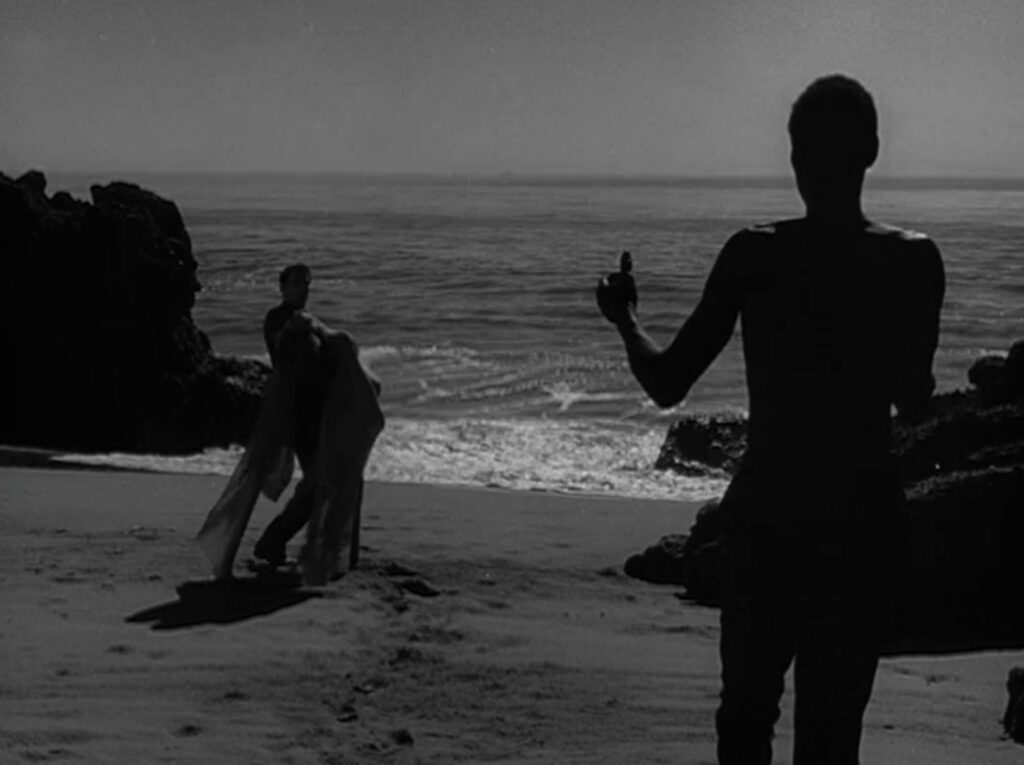
I Walked with a Zombie
1943, directed by Jacques Tourneur
On the first morning of Betsy Connell’s employment at Fort Holland, the old sugar plantation on the Caribbean island of Saint Sebastian, the maid Alma wakes her up by squeezing her big toe. “I didn’t want to frighten you out of your sleep, miss, that’s why I touched you farthest from your heart.” Such gentleness is typical of I Walked with a Zombie, a movie usually counted as horror but which favors the spooky over the frightening. This gentleness extends in multiple directions, part of a strategy that enables the film to say things that could not normally be said in 1943.
Were it not for its gentle approach, the movie could have raised a scandal. It begins with a white woman walking along a beach with a black man. Both are in silhouette, diminishing the provocation, and the fact that the man is a zombie ironically makes the pairing more palatable in a racist and sexist world. He’s “only” an implicit threat to her life, not to her maidenhood. In its quiet fashion the film’s title serves notice that it will mix races in surprising ways. Although a zombie back then was stereotypically a black man, Jessica is the more destructive zombie, a conceited white woman who tore a family apart, whereas the black zombie Carrefour proves gentle and helpful, carrying Jessica’s body back to Fort Holland at the end.
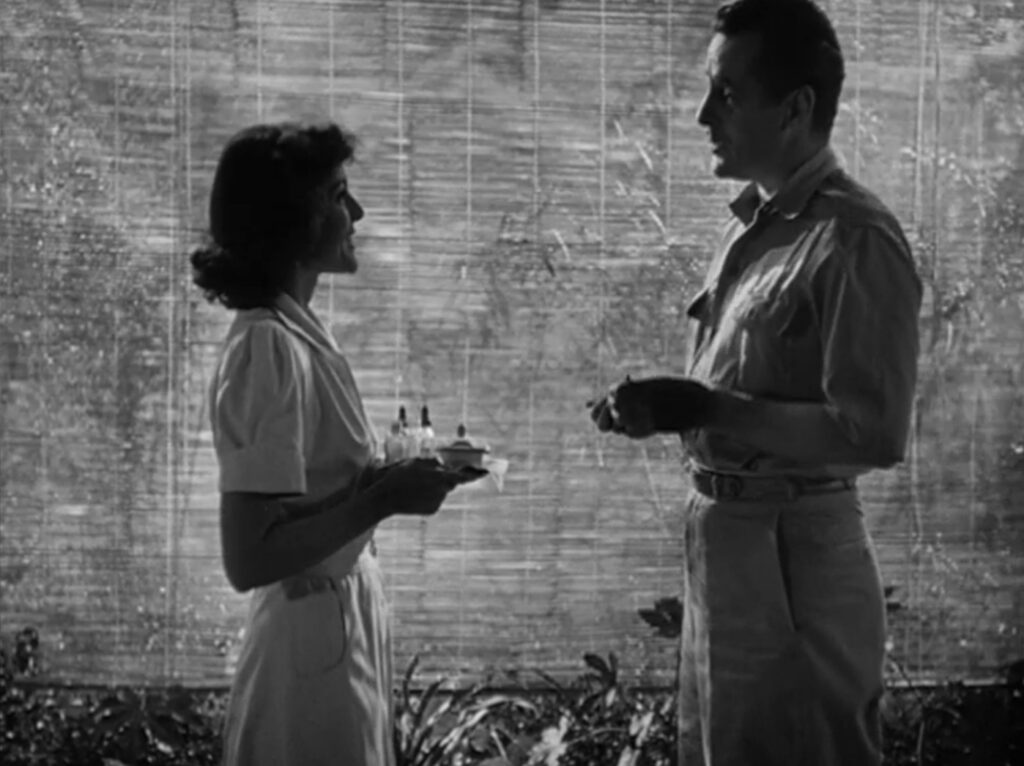
I Walked with a Zombie does not try to reverse prejudice by creating white villains and sympathetic black characters. Doing that wouldn’t change a lot of minds. In fact the movie shows an advanced awareness of the mechanics of persuasion:
- At Mrs. Rand’s urging, Betsy Connell asks Paul Holland to leave the whiskey decanter off the dining table. He refuses, saying it’s been there for generations, but at the next meal he’s changed his mind and ordered the decanter gone.
- After repeatedly begging a native mother to boil her baby’s drinking water, Mrs. Rand finally persuaded her by saying the god Shango would kill the evil spirits in the water if she boiled it.
- Betsy shows Alma that the easiest way to lead a horse is to turn your back to it. “You can’t look at a horse and lead him at the same time.”
These examples show how persuasion works gently when it works at all. It leaves room for resistance, it respects the target’s beliefs, and it leads by example. All of the diegetic music in I Walked with a Zombie is a correlative to persuasion, always beckoning someone to another side. The voices on the schooner figuratively transport Betsy from Antigua to Saint Sebastian; the “jungle drums” summon workers to the sugar mill; the calypso singer brings three of the main characters together in the town square; the piano draws Betsy to her first romantic conversation with Paul; the voodoo chants pull Betsy and Jessica to the Houmfort; rhythmic music underscores the magic force of the voodoo doll pulling Jessica to to her merciful death; and the fishermen coax Jessica’s body out of the water with their low singing.
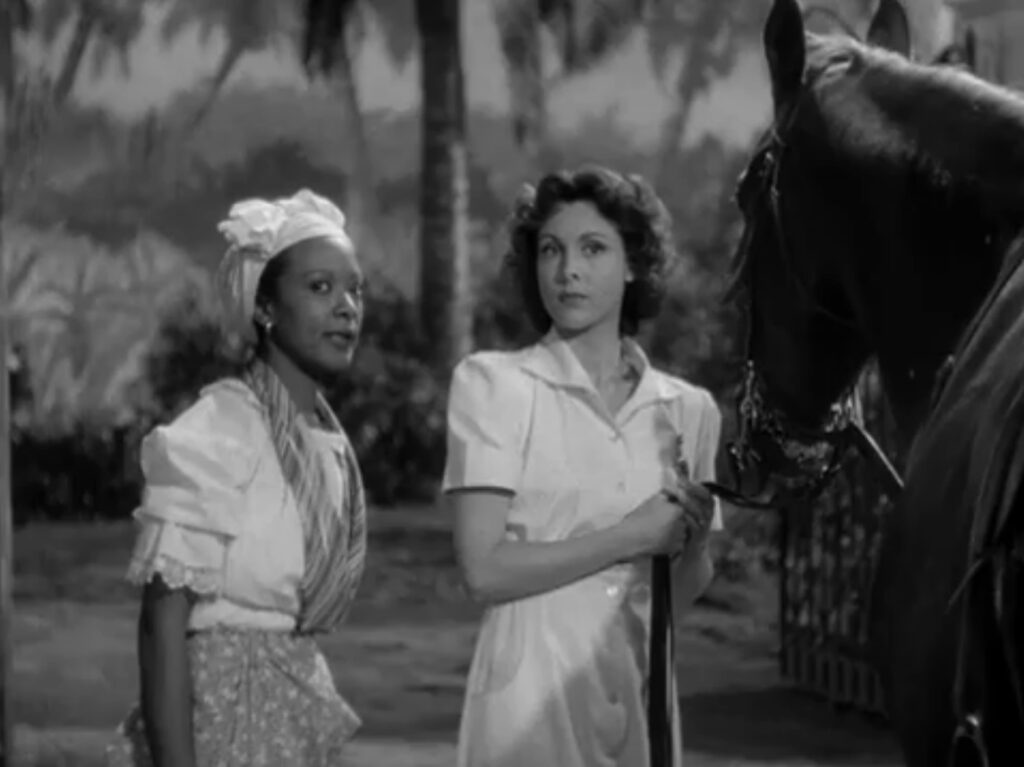
I Walked with a Zombie was released at the height of World War II, and its contribution to the war effort is not obvious, but its attack on racial prejudice aimed to strengthen the United States both internally and as a fighting power. Although the armed forces remained segregated until three years after the war, it was still necessary to foster cooperation between all sectors of the military and civilian populations. If Roosevelt’s Good Neighbor Policy was enough reason for Hollywood to make movies that encouraged good feelings toward Latin America during the war, surely it made sense to build racial unity as well.
The subtle attack on racism in I Walked with a Zombie, and the movie’s modeling of persuasive techniques, show that Hollywood was far ahead of the transparent propaganda in film industries of other combatant countries. The trouble with propaganda is that it tries to “look at its audience and lead it at the same time” like Alma tugging on the horse. Propaganda may still be effective – humans can be easier to persuade than horses – but it’s too often not done in good faith.
Instead of trying to shatter racial stereotypes in a reflexive way by associating blackness with virtue, or whiteness with corruption, I Walked with a Zombie systematically links blackness with agency, i.e. with power in its benign form, and darkness with beauty. Likewise, instead of making generalizations about black or white people, it translates the black-white dichotomy into contrasts in clothing and between day and night.
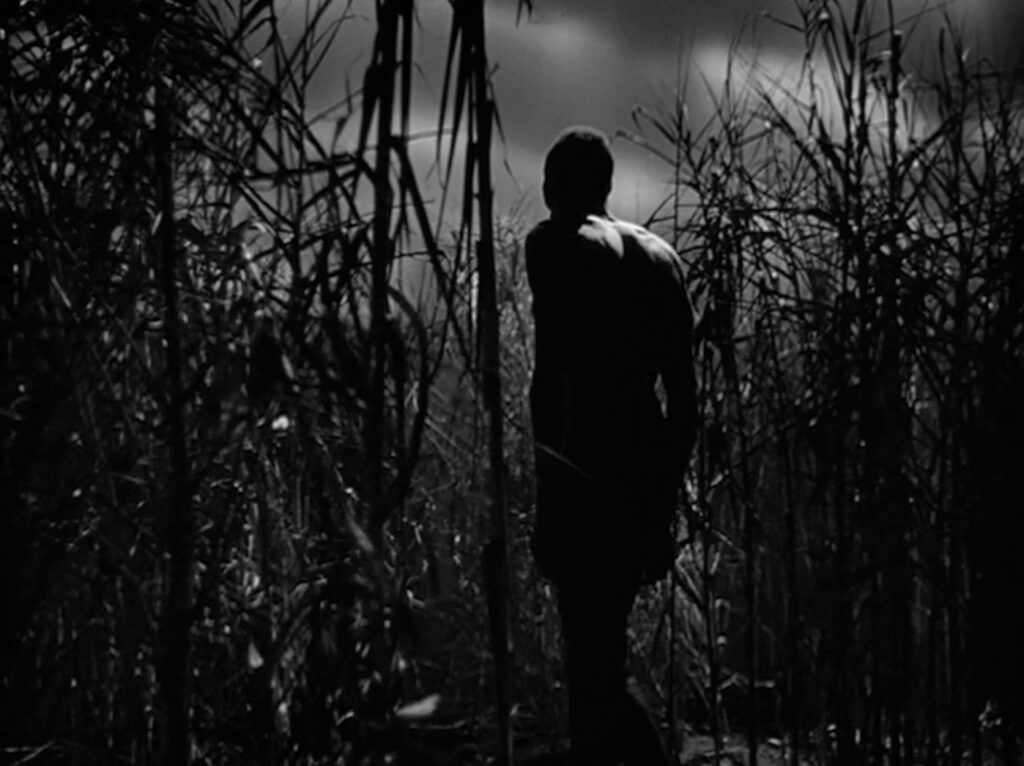
Whoever wears white is usually helpless or passive, while characters in dark clothing are active or in control. In her white nurse’s uniform Betsy takes orders from Paul Holland and Dr. Maxwell, but she wears a black cloak while leading Jessica to the Houmfort. Contrary to Betsy’s first impression of her, Jessica is helpless and easily led in her white gown. Carrefour wears dark pants, and though he too is a zombie, he guards the Houmfort and plays a more active role than Jessica. Alma and the servants usually wear white, but Paul Holland, master of the house and the sugar mill, wears a dark suit. The sabreur who directs the voodoo ceremonies is dressed in black. Clement, the chief house servant, wears white while serving but black when he helps save Betsy from Jessica, and at the end of that scene he orders Alma to keep quiet. The calypso singer wears white and obeys Wesley’s order to stop singing, but when night darkens his clothes he is emboldened to resume. The island’s sole police officer is a horse, and it’s black. Alma gives Betsy and Jessica voodoo patches to get them safely to the Houmfort, but Betsy loses her white patch, and it’s Jessica’s black patch that saves them.
On the other hand, when Betsy leads the horse, she’s dressed in white. The scene puts her in control, so it would seem to break the pattern, but the point is that Betsy is not actually leading the horse but walking with him as an equal. The act of walking together is a metaphor for harmony, as the movie’s title and opening shot imply.
Like this pattern of light and dark clothing, the movie also distinguishes carefully between day and night. The first two scenes are split between day (with snow falling) and night (with a falling star). Betsy’s daytime interview in Ottawa is visually flat, but the overnight boat ride is gorgeous, and henceforth most of the film’s beauty will occur at night: the walk through the sugar cane, the garden at Fort Holland, the scenes by the ocean, and the moonlight streaming through venetian blinds. The calypso scene is split in half by a gas lamp separating day from night, and Wesley’s drunken irritation there gives way to the reassuring presence of Mrs. Rand.
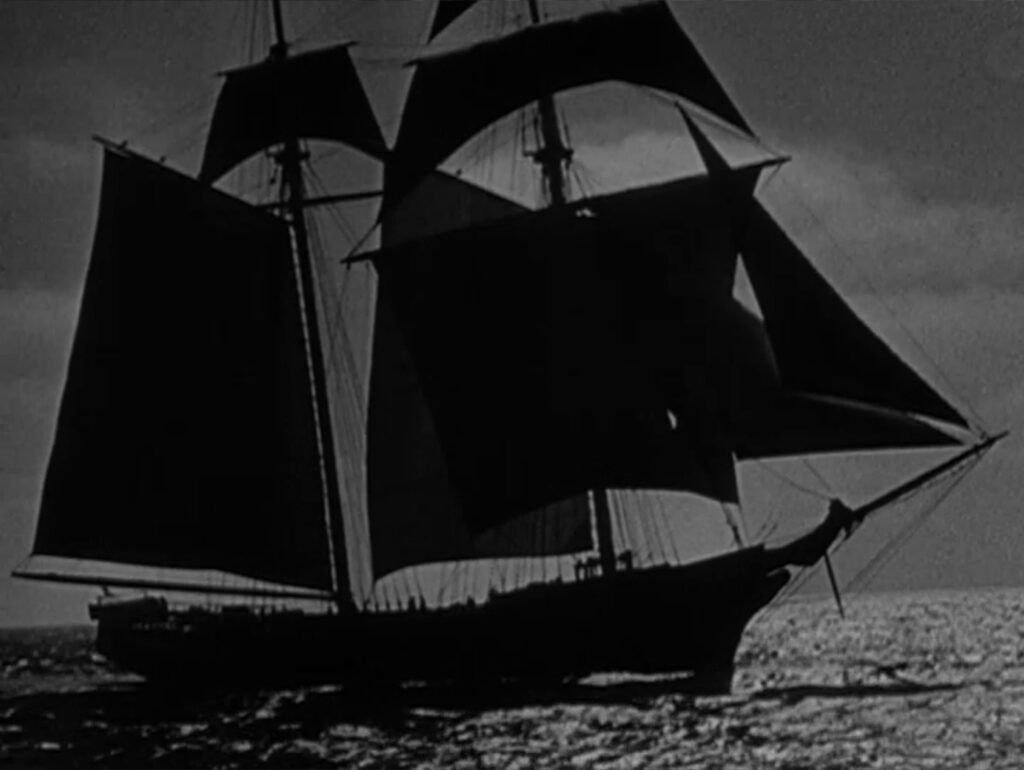
Implying that beauty resides in darkness is a subtle way to undermine racism. Like Betsy’s request to remove the decanter from the table, it might not produce immediate results, but it lays a foundation for a new frame of perception. It might be too subtle to reach the audience consciously, but the script reinforces the idea by calling attention a couple times to Betsy’s purported fear of the dark. Fear of the dark is a metaphor for racism, and by framing it this way the movie makes racism seem childish and unbecoming to adults.
I Walked with a Zombie invites us to think in new ways about our stereotypes, and it prepares us to shift our thinking by reminding us again and again that things may not be what they seem. The Caribbean appears beautiful, but Paul tells Betsy it’s not. The black workers cry at a birth and rejoice at a funeral. Betsy’s brioche looks like a giant meal but turns out to be full of air. Mrs. Rand seems like a rational and scientific woman, but she finds herself convinced by voodoo beliefs. The movie itself is ambiguous about the power of voodoo – Wesley stabs Jessica at the same moment that the sabreur stabs the voodoo doll.
The arc of I Walked with a Zombie brings Jessica and Paul together, but it’s not a simple romance. Each of them must change before they’re matched, and again the changes point subtly toward a larger topic that defines American society in 1943. Paul is afraid of himself; he knows he harbors a wish to destroy whatever is beautiful, and as Wesley tells Betsy, he uses the word “beautiful” as a weapon. Betsy, on the other hand, is too easily seduced by beauty, allowing it to distract her from reality. Arriving at Saint Sebastian she tells the coach driver, with astonishing insensitivity, that the slave ships brought his ancestors to a beautiful place.
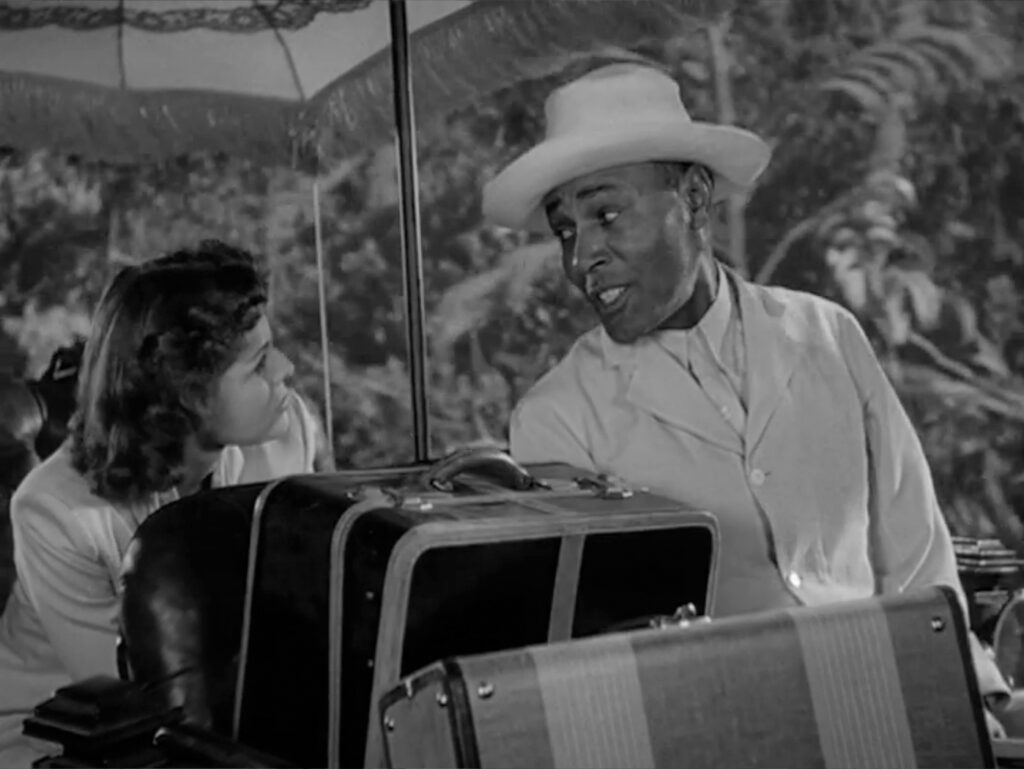
With its history of slavery and its lingering plantation economy, Saint Sebastian is a microcosm of the United States, and Paul and Betsy represent two sides of white America. Paul stands for the inherited brutality of his slaveholder ancestors, and Betsy stands for the naïvety of whites who passively accept their legacy. The movie doesn’t bring them all the way to either marriage or self-awareness, but it brings them closer, just as it tries to bring the audience closer to overcoming its own racist history. Its purpose is timeless, but it speaks to a moment when the struggle against racism was particularly urgent, when the nation’s enemies took racism to genocidal extremes.
CONNECTIONS:
The Cabinet of Dr. Caligari – Lighting of a gas lamp calls attention to a vital clue
Abraham Lincoln – Coded use of black & white, light & dark
Rebecca – Male protagonist is surprised at his new wife’s/lover’s assumption that he still loves his first wife
Holiday Inn – Wartime movie whose contribution to the war effort is not obvious
Black Narcissus – Attempt to change attitudes on the home front through gentle persuasion
The Naked Jungle – Woman comes to a plantation, owner is a forbidding and difficult man, a force of nature or spirits throws a wrench into the plot and brings the woman and man together
Elephant Walk – Woman comes to a plantation, owner is a forbidding and difficult man, a force of nature or spirits throws a wrench into the plot and brings the woman and man together
The Night of the Hunter – Effort at gentle persuasion against racism; Expressionist cinematography
The Wind Will Carry Us – Reversal of assumed value between black & white or low & high
Melancholia – Similarity to The Naked Jungle; siblings with American and British accents
Get Out – Black & white clothing or objects that point to insights about racism